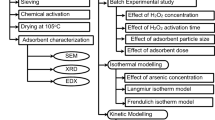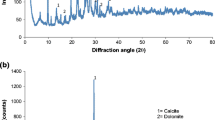Abstract
The removal of As(V) from aqueous solutions by leonardite loaded with ferric ions (Fe-leonardite) has been investigated. The influence of pH, contact time, and arsenate concentration on the adsorption process were evaluated. Batch kinetic studies showed that equilibrium time was reached at 24 h of contact time. Equilibrium data obtained with low initial arsenate concentrations (10–400 ppb) were fitted to both Langmuir and Freundlich models, and the maximum adsorption capacity was estimated to be 322 μg g−1. Arsenic sorption was evaluated in continuous mode to reproduce industrial applications and to determine the conditions where the process was controlled by either mass transfer or reaction rate. A maximum sorption capacity of 905 μg g−1 was obtained in continuous experiments. These results indicate that Fe-leonardite is a great potential material for removing arsenate at low initial concentrations from contaminated water.






Similar content being viewed by others
References
Bhattacharya, P., Welch, A. H., Stollenwerk, K. G., McLaughlin, M. J., Bundschuh, J., & Panaullah, G. (2007). Arsenic in the environment: biology and chemistry. The Science of the Total Environment, 379(2–3), 109–120. doi:10.1016/j.scitotenv.2007.02.037.
Bohart, G. S., & Adams, E. Q. (1920). Some aspects of the behavior of charcoal with respect to chlorine. Journal of the Chemical Society, 42, 523–544.
Chuang, C. L., Fan, M., Xu, M., Brown, R. C., Sung, S., Saha, B., & Huang, C. P. (2005). Adsorption of arsenic(V) by activated carbon prepared from oat hulls. Chemosphere, 61(4), 478–483. doi:10.1016/j.chemosphere.2005.03.012.
Dong, L., Zinin, P. V., Cowen, J. P., & Ming, L. C. (2009). Iron coated pottery granules for arsenic removal from drinking water. Journal of Hazardous Materials, 168(2–3), 626–632. doi:10.1016/j.jhazmat.2009.02.168.
Dupont, L., Jolly, G., & Aplincourt, M. (2007). Arsenic adsorption on lignocellulosic substrate loaded with ferric ion. Environmental Chemistry Letters, 5(3), 125–129. doi:10.1007/s10311-007-0092-3.
Gang, D. D., Deng, B., & Lin, L. (2010). As(III) removal using an iron-impregnated chitosan sorbent. Journal of Hazardous Materials, 182(1–3), 156–161. doi:10.1016/j.jhazmat.2010.06.008.
Ghimire, K. N., Inoue, K., Yamaguchi, H., Makin, K., & Miyajima, T. (2003). Adsorptive separation of arsenate and arsenite anions from aqueous medium by using orange waste. Water Research, 37, 4945–4953.
Gu, Z., Fang, J., & Deng, B. (2005). Preparation and evaluation of GAC-based iron-containing adsorbents for arsenic removal. Environmental Science and Technology, 39, 3833–3843. doi:10.1021/es048179r.
Guo, H., Stüben, D., & Berner, Z. (2007). Adsorption of arsenic(III) and arsenic(V) from groundwater using natural siderite as the adsorbent. Journal of Colloid and Interface Science, 315(1), 47–53. doi:10.1016/j.jcis.2007.06.035.
IARC. (2004). Some drinking-water disinfectants and contaminants, including arsenic. IARC Monographs on the Evaluation of Carcinogenic Risks to Humans, 84, 1–477.
Kim, J., Mann, J. D., & Spencer, J. G. (2006). Arsenic removal from water using lignocellulose adsorption medium (LAM). Journal of Environmental Science and Health. Part A, Toxic/Hazardous Substances & Environmental Engineering, 41, 1529–1542. doi:10.1080/10934520600754284.
Lao, C., Zeledón, Z., Gamisans, X., & Solé, M. (2005). Sorption of Cd(II) and Pb(II) from aqueous solutions by a low-rank coal (leonardite). Separation and Purification Technology, 45(2), 79–85. doi:10.1016/j.seppur.2005.02.006.
Livens, F. R. (1991). Chemical reactions of metals with humic material. Environmental Pollution, 70, 183–208. doi:10.1016/0269-7491(91)90009-L.
Mikutta, C., & Kretzschmar, R. (2011). Spectroscopic evidence for ternary complex formation between arsenate and ferric iron complexes of humic substances. Environmental Science & Technology, 45(22), 9550–9557. doi:10.1021/es202300w.
Mohan, D., & Pittman, C. U. (2007). Arsenic removal from water/wastewater using adsorbents—a critical review. Journal of Hazardous Materials. doi:10.1016/j.jhazmat.2007.01.006.
Muñoz, J. A., Gonzalo, A., & Valiente, M. (2002). Arsenic adsorption by Fe(III)-loaded open-celled cellulose sponge. Thermodynamic and selectivity aspects. Environmental Science & Technology, 36(15), 3405–3411. http://www.ncbi.nlm.nih.gov/pubmed/12188372.
Official Journal of the European Union (1998). Council Directive 98/83/EC of 3 November 1998 on the quality of water intended for human consumption.
Payne, K., & Abdel-Fattah, T. (2005). Adsorption of arsenate and arsenite by iron-treated activated carbon and zeolites: effects of pH, temperature, and ionic strength. Journal of Environmental Science and Health, Part A, 40(4), 723–749. doi:10.1081/ESE-200048254.
Rahaman, M. S., Basu, A., & Islam, M. R. (2008). The removal of As(III) and As(V) from aqueous solutions by waste materials. Bioresource Technology, 99, 2815–2823.
Smedley, P. L., & Kinniburgh, D. G. (2002). A review of the source, behaviour and distribution of arsenic in natural waters. Applied Geochemistry, 17(5), 517–568. doi:10.1016/S0883-2927(02)00018-5.
Solé, M., Casas, J. M., & Lao, C. (2003). Removal of Zn from aqueous solutions by low-rank coal. Water, Air, and Soil Pollution, 144, 57–65. doi:10.1023/A:1022965417124.
Thirunavukkarasu, O. S., Viraraghavan, T., & Subramanian, K. S. (2003). Arsenic removal from drinking water using iron oxide-coated sand. Water, Air, and Soil Pollution, 142, 95–111.
USEPA (2002). Arsenic treatment technologies for soil, waste, and water. Office of Solid Waste and Emergency Response, EPA 542-R-(02-004).
Vaughan, R. L., & Reed, B. E. (2005). Modeling As(V) removal by a iron oxide impregnated activated carbon using the surface complexation approach. Water Research, 39(6), 1005–1014. doi:10.1016/j.watres.2004.12.034.
Wolborska, A. (1989). Adsorption on activated carbon of p-nitrophenol from aqueous solution. Water Research, 23, 85–91. http://www.scopus.com/inward/record.url?eid=2-s2.0-0024498236&partnerID=tZOtx3y1.
Yadanaparthi, S. K. R., Graybill, D., & von Wandruszka, R. (2009). Adsorbents for the removal of arsenic, cadmium, and lead from contaminated waters. Journal of Hazardous Materials, 171(1–3), 1–15. doi:10.1016/j.jhazmat.2009.05.103.
Zeledón-Toruño, Z., Lao-Luque, C., & Solé-Sardans, M. (2005). Nickel and copper removal from aqueous solution by an immature coal (leonardite): effect of pH, contact time and water hardness. Journal of Chemical Technology & Biotechnology, 80, 649–656. doi:10.1002/jctb.1243.
Zeledón-Toruño, Z. C., Lao-Luque, C., de Las Heras, F. X. C., & Sole-Sardans, M. (2007). Removal of PAHs from water using an immature coal (leonardite). Chemosphere, 67(3), 505–512. doi:10.1016/j.chemosphere.2006.09.047.
Zhang, F. S., & Itoh, H. (2005). Iron oxide-loaded slag for arsenic removal from aqueous system. Chemosphere, 60(3), 319–325. doi:10.1016/j.chemosphere.2004.12.019.
Zhang, W., Singh, P., Paling, E., & Delides, S. (2004). Arsenic removal from contaminated water by natural iron ores. Minerals Engineering, 17(4), 517–524. doi:10.1016/j.mineng.2003.11.020.
Zouboulis, A. I., & Katsoyiannis, I. A. (2002). Arsenic removal using iron oxide loaded alginate beads. Industrial & Engineering Chemistry Research, 41(24), 6149–6155. doi:10.1021/ie0203835.
Acknowledgments
We thank undergraduated students Zoe Alique and Nuria Torras for their collaboration.
Author information
Authors and Affiliations
Corresponding author
Rights and permissions
About this article
Cite this article
Solé-Sardans, M., Gamisans, X., Dorado, A.D. et al. Exploring Arsenic Adsorption at low Concentration onto Modified Leonardite. Water Air Soil Pollut 227, 128 (2016). https://doi.org/10.1007/s11270-016-2827-x
Received:
Accepted:
Published:
DOI: https://doi.org/10.1007/s11270-016-2827-x




